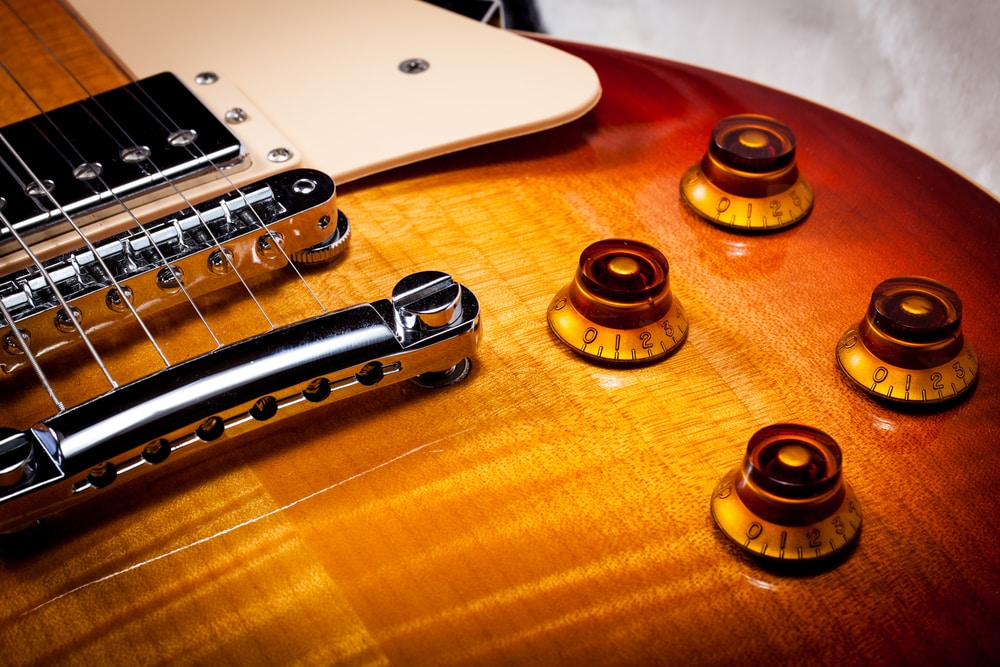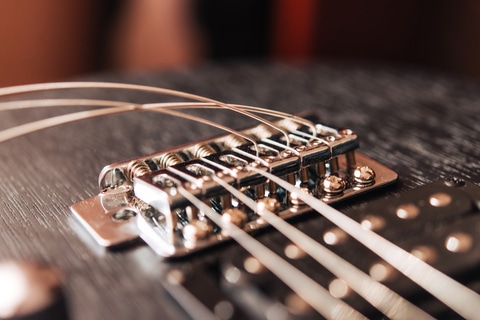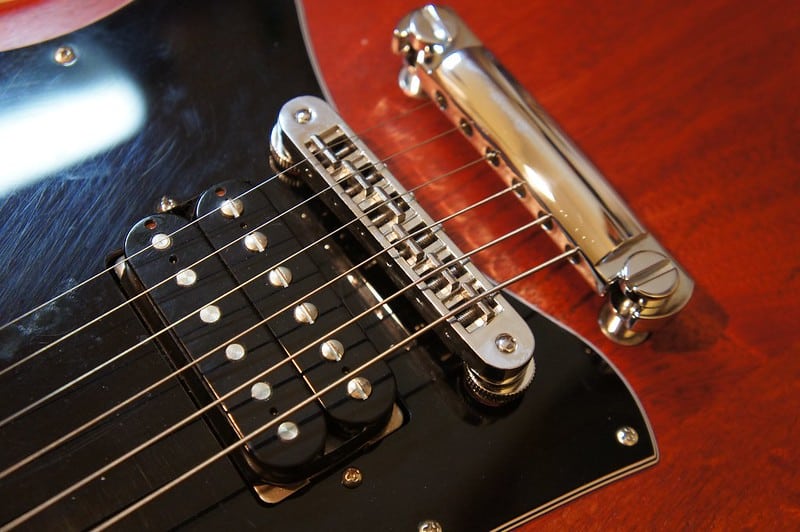
Ever since the launch of guitars, the music industry has witnessed a revolution. More and more equipment is being made to be used along with guitars and hence, produce better music.
One such piece of equipment is a bridge that allows the users to access multiple tunes at the same time.
Tune o Matic is a popular aftermarket bridge that makes it easier for you to intonate the guitar. It consists of separate pieces of tail-piece and bridge. You can even add a tremolo arm to it.
As far as the sound produced from this bridge is concerned, it is warm and rich. The design of the Tune o Matic bridge is used on most of the Les Paul guitars, including Classic, Standard, and Modern.
However, you should be aware of the intonation problems caused by the Tune o Matic bridge. If the intonation is out, even the greatest guitars in the world can sound like trash.
You cannot stay in Tune unless you get the intonation right. It doesn’t matter where you play on the fretboard. You just need to have the right intonation to always stay in Tune.
The sad news is that there has been a significant change in the intonation of the guitars over time.
In this article, we will discuss some ways you can effectively and efficiently solve the intonation problems of the Tune o Matic bridge effectively and efficiently.
How to Fix The Tune o Matic Bridge Intonation Problem
1. Tune o Matic Saddles All The Way Back
If you have a sharp intonation and you want to bring an increase in the length of the string. As you make the adjustment in the saddle and check the intonation again but it is still out.
The bridge saddle has gone all the way back with the intonation still out. The further adjustment becomes impossible for you because the spring responsible for holding the saddle in place gets compressed up to a point.
First of all, the thing that needs to be checked is the bow of the guitar’s neck. If the neck of the guitar has a concave bow, it throws off the intonation.
If the problem remains despite the proper setup of the neck, it could be the bad strings causing the problem.
The contact of the string with the bridge saddle is crucial in the intonation. If the issue concerns just one or two strings, replace them.
2. Action Height And Intonation
The action height of your guitar largely impacts the intonation. If the action is higher, there will be more throwing off of the intonation.
The reason is that the goal of the string is to reach the fret, and it needs to be pushed further. The string is pushed out of the Tune because of the extra distance.
A lower action height doesn’t have a drastic impact on intonation. But it does come with its downsides, including the buzzing frets. Therefore, you must decide what height is perfect for you.
3. Careful Installation
Bridges that are not made by the OEM require you to be careful and precise about the installation. Even a little bit of alignment issue can cause a big problem for the intonation.
That is why you need to install the Tune o Matic bridge, right. If you have no previous experience in this regard, it is better to get in touch with a professional who can do the job for you.
4. Adjusting It Right
There are a number of stages that the Tune o Matic bridge can be adjusted at. You can prevent plenty of problems if you just adjust this bridge properly.
On the other hand, the Tune o Matic bridge can get passed up if there is any mistake in the adjustment. Another thing that you need to be careful about is never changing the bridge when you are playing the guitar.
It badly affects the intonation. The aftermarket bridges like Tune o Matic need different tuning as compared to the default settings that you have had on the tuner. So make sure you tune it accordingly.
There is a different method of adjusting the intonation on guitar depending on the type of guitar. You can either increase or decrease the length of the guitar’s string to adjust the intonation.
You can do this in the easiest way by adjusting the position of the Tune o Matic bridge. The adjusting of the bridge position is an easy job on some guitars.
As far as the acoustic guitars are concerned, it is almost impossible to adjust their bridge positions. There are some rules which you need to follow for locating the right direction to adjust your Tune o Matic bridge.
A sharp fretted 12th fret note requires that the length of the guitar string needs to be increased. As you increase the length of the string, there is a decrease in the pitch of the fretted note.
Make sure the increase in the length of the string is gradual, and it keeps going on until there is perfect matching between the pitch of the fretted note and the pitch of the 12th fret harmonic.
As you take the bridge saddle further away from the fretboard, there is an increase in the length of the string. The more the distance from the fretboard, the longer the string gets.
If the pitch of the fretted 12th fret note is lower than the harmonic, you need to bring a decrease in the length of the string. It will result in an increase in the pitch of the fretted note, and it will ultimately be equivalent to the pitch of the 12th fret harmonic.
Get the length of the string shortened by moving your bridge saddle closer to the fretboard. A decrease in the length of the string makes the string lose, so there is no need to loosen it before you adjust the bridge.
In Tune o Matic bridge, there is a small roller saddle on which each string is resting. The saddle can smoothly move back or forth because it has some room to do so.
The other side of the bridge has a screw for each string. The position of the roller saddle is well adjusted with the help of these screws.
The screw needs to be turned clockwise so that there is a decrease in the length of the string. You should take this step when the fretted note is flat.
On the other hand, a sharp fretted note requires an increased string length, so turn the screw anti-clockwise.
5. Loosen The Strings While Adjusting Intonation
As you are adjusting the bridge saddle by moving it away from the fretboard, you are increasing the length of the string. In addition, it also brings a rise in the tension in your string.
It is recommended to de-tune the string before you adjust the saddle so that both the string and the saddle are protected from any possible damage.
Just like that, an adjustment in the bridge that brings a decrease in the length of the string also causes the string tension to decrease.
In simple words, there is nothing bothersome about de-tuning the string beforehand. The adjustment of a Tune o Matic bridge demands the string to be slack before the adjustment of the hex nut.
Keep in mind that the string needs to be returned before you recheck the intonation.
6. Bridge Compensation
For these solutions, you have to be creative because it is highly related to the manufacturing skills of the manufacturer. Regardless of the model, the process is always the same. You just need to tune your guitar.
For that, the truss rod of the guitar needs to be adjusted. Get the neck of your guitar straightened. The harmonics of the guitar need to be kept in check every once in a while.
There is another option with which you can get more precision and accuracy. It includes the use of a tuner instead of an ear to tune your guitar. You can easily notice the poor intonation.
The harmonics on the 12th fret need to be checked because beyond this threshold is where the poor intonation is clear.
7. Gibson Nut Compensation
The first thing that you need to do is take the nut off the slot. You can do this by using a small wood piece. Place this piece against the nut of the guitar and keep pulling the wood piece until the nut is out of the slot.
You need to be careful while taking the nut out because an overkill can ruin the entire procedure. Once you are done removing the run, shorten the fingerboard of your guitar all the while.
8. Bad Bridge And Nut Setup
The behavior of the strings is highly affected by the bridge and nut setup. An improper setting of either of these leads to a bunch of problems, of which bad intonation is the biggest one.
Conclusion
It is easy to solve the intonation problems related to the guitar bridge as long as you keep your instrument under regular maintenance.
Besides, if you keep playing the bridge, you can notice the intonation problems faster and look for their solutions.
Apart from a few situations where heavy tinkering is required, you can solve the rest of the intonation problems on your own.


